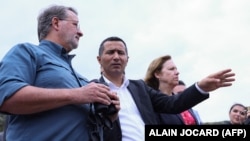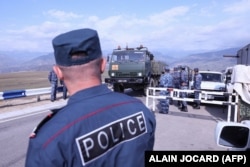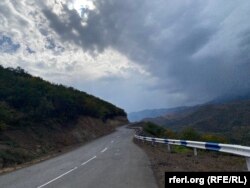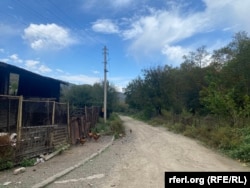ACHANAN, Armenia -- On a rainy afternoon in this highland village, a group of local dignitaries, Armenian government representatives who'd made the long drive down from Yerevan, and European donors gathered at a cow barn. They were here to cut the ribbon on the renovated facility, which had been redesigned to safely house its new residents: 19 cows imported from Austria.
The cows observed the October 24 ceremony with curiosity, poking their heads through the railings of their confinement to get a closer look at the officials and accompanying TV crews. One of the enterprise's workers, Razmik Grigorian, marveled that the carefully bred Austrian cows could produce around 30 liters of milk a day. Armenian cows, he said, produce only about 10 liters.
The livestock purchase was funded by the Austrian Development Agency as part of a European Union initiative launched earlier this year, Resilient Syunik. The program will provide more than 100 million euros ($106 million) to fund small-scale development projects like this one in Armenia's southernmost region.
While the individual projects are modest, the overall aim is ambitious: to bolster the security of Syunik, which has become newly vulnerable following Azerbaijan's victory in the 2020 Second Karabakh War. The results of that war disrupted the region's economy, and many fear that Baku may have designs on Syunik, especially after Azerbaijan's lightning military offensive in September of this year that resulted in the Karabakh's leadership's full surrender and the exodus of more than 100,000 ethnic Armenians.
Whether they're well-founded or not, those fears have raised concerns of a gradual depopulation of the region, rendering it still more vulnerable.
"If you live near the border, there is pressure in your heart," said Vahe Hovannisian, a project manager at the NGO that implemented the cow-import program and himself a Syunik native.
The Achanan ceremony was organized "for others to see that even in these difficult times, there is some project, someone who is investing and implementing some initiatives, that there is hope here, to show people that remaining here has potential," he said.
Resilient Syunik "is very much a political signal," said one Western diplomat in Yerevan, requesting anonymity in order to speak more openly. "It is a political demonstration that Europe cares."
A New Hot Spot
The European cows are just one element in what has become a complicated geopolitical knot in Syunik. The changes are visible everywhere: A large Iranian flag flies above the regional capital, Kapan, at a consulate that was opened last year. The EU, in addition to its new development program, has stationed border monitors in Syunik. Russia has also expanded its border-guard presence in the region.
The various parties now coexist uneasily in the territory, and for some residents, all of the attention has only made them feel less secure.
"Do not play this game with Armenia. Is it Russia's or the West's?" said one Kapan native, Armen Ghazarian, who now heads an environmental NGO here. "Please don't play that game. That game is OK for you, but it's a threat for us."
Syunik is Armenia's most remote province, making up the country's narrow southern tip. Its slim southern edge borders Iran; across its eastern border is Azerbaijan's mainland; and to its west is Azerbaijan's exclave of Naxcivan. The region's strategic location, combined with its prominent place in Armenian history, makes it, in Armenian discourse, the "backbone" of the country.
Regional and international attention began to turn to Syunik immediately following the 2020 Second Karabakh War, when Azerbaijan retook most of the territory it had lost to Armenian forces in the first war between the two sides in the 1990s. That territory included the Azerbaijani provinces of Zangilan, Qubadli, and Lachin, all of which border Syunik.
When those territories were occupied by ethnic Armenians, Syunik's eastern border was effectively nonexistent. Many Syunik residents grew crops on the other side of the border or grazed their livestock there. The Soviet-built road that served as Syunik's main north-south artery dipped in and out of occupied Azerbaijani territory.
But after Azerbaijan's victory in 2020, Baku quickly moved to reassert its sovereignty over its retaken territory. Azerbaijan moved troops right up to the edge of the border of Syunik, erecting border guard posts, large flags, and signs reading "Welcome to Azerbaijan" in English and Azeri -- but not Armenian. Azerbaijani authorities took control of their sections of the highway, making travel on it impossible and forcing traffic on to smaller, rougher roads away from the border.
At the same time, Azerbaijani officials began to advance ambiguous claims on Syunik. As part of the cease-fire that ended the 2020 war, Armenia and Azerbaijan agreed to cooperate on new transportation routes that would connect Azerbaijan's mainland with its exclave of Naxcivan. While Syunik wasn't explicitly named in the agreement, it is the shortest route between the two parts of Azerbaijan and Soviet-era transport infrastructure remains through the region that could be restored.
Soon after, though, Azerbaijani President Ilham Aliyev began publicly making demands that went beyond the text of the agreement: He called the route the Zangezur Corridor (using an alternate name for Syunik) and said Armenians would have no jurisdiction over it. Aliyev followed up with thinly veiled threats to seize the land for the corridor by force if Armenia didn't comply.
Parallel to the Zangezur Corridor demands, Aliyev also began promoting a discourse that identified parts of Armenia -- in particular Syunik -- as "Western Azerbaijan," from which ethnic Azerbaijanis had been unjustly forced out and to which they should return.
Azerbaijan has insisted that such pronouncements do not amount to territorial claims on Armenia. Since the September offensive, Aliyev has said that if Armenia doesn't want to host a corridor to Naxcivan, it will build a road through Iran instead. And he said that Azerbaijanis would return to Western Azerbaijan "not in tanks, but in their cars."
'Every Day, There Is An Expectation Of War'
Still, in an unpredictable environment, all bets are off.
"We don't have any information to imply that [an Azerbaijani attack against Armenia in Syunik] is imminent in any way. Azerbaijan said clearly they have no intentions of threatening Armenian sovereign territory, and they've been very clear on that," one senior U.S. official told RFE/RL, preferring to speak on the condition of anonymity.
"They were pretty clear [they did not plan to use force] in Nagorno-Karabakh. So, we have no clear indications that anything is happening. But because of what's happened, you can't help but be concerned. So that's why we're watching," the official said.
This uncertainty is putting many residents of Syunik on edge.
"Every morning I wake up and think, good, today there is no war, because every day there is an expectation of war," said Tigranuhi Badalian, a journalist at Zangezur TV, a channel covering news in Syunik.
"I don't much like watching the president of Azerbaijan, but every day, before I go to sleep, I watch videos of what he said, and analyze whether there will be war tomorrow or not. And every time I want to buy something for my home, do some repairs, or buy some furniture, I think: What if a war starts tomorrow? I will lose everything."
That fear has led to worries that people could move out of Syunik, a very sensitive topic in the region. There is no data on how many people might have left already, and residents surveyed had widely varying takes.
"There is no safe place in the world right now. Even if it's not totally safe here, no one is going to leave Syunik. We will stand and fight until the end against our enemies," said Vahan Sargsian, a veterinarian in Kapan.
But his friend, Shushanik Kostandian, a freelance tour guide who was translating for him, pushed back: "Lots of people are doing everything they can do to leave Syunik and live a normal life," she said.
Growing Western Involvement
Resilient Syunik was launched in January. In May, EU officials announced that the money dedicated to it would more than double, to 116 million euros ($123 million), of which 40 million euros are grants and 76 million euros are loans.
The money is funding dozens of small development projects, from educational programs and job skills training to aid for small enterprises to get started or expand to improving local government capacity. While EU donors had been involved in Syunik before, Resilient Syunik "is about coordinating the scattered presence and scattered activities of different players to show there is a common shared vision," the Western diplomat said.
The program was launched after the Armenian government asked the European Union to reorient its development efforts from the northern part of the country -- its poorest -- to Syunik, according to another Western diplomat in Yerevan.
Syunik is "vital" and "strategic" for Armenia, the country's deputy prime minister, Mher Grigorian, said at the launch ceremony for Resilient Syunik in January. "So any project aimed at sustainable development of the region is in the center of special attention of the government."
The launch of the aid program came as the EU, with support from the United States, had been taking an unprecedentedly large role in the resolution of Armenia's long-running conflict with Azerbaijan.
Baku and Yerevan were locked in a conflict over the region of Nagorno-Karabakh for decades. Armenian-backed separatists seized the mainly ethnic Armenian-populated region from Azerbaijan during a war in the early 1990s that killed some 30,000 people. Diplomatic efforts to settle the conflict brought little progress, and the two sides fought another war in 2020 that lasted six weeks before a Russian-brokered cease-fire, resulting in Armenia losing control over parts of the region and seven adjacent districts.
In 2022, the two sides again began negotiations to reach a peace agreement to end the conflict. Before 2020, the Armenia-Azerbaijan talks had been jointly led by the United States, France, and Russia, a rare forum for Western-Russian cooperation. But the talks that began in 2022 proceeded on two rival tracks: the EU and United States on one side and Russia on the other, each trying to broker a deal.
On those two tracks, there was a clear divergence in the approaches toward the most sensitive issue: the fate of Nagorno-Karabakh. The Russian approach was to delay a resolution of that issue until after other issues had been addressed. The Western track sought a compromise on Karabakh that would acknowledge Azerbaijani sovereignty over the territory while ensuring the rights and security of the ethnic Armenian population there. The Russian variant would, as it happens, provide a justification for extending the mandate of the 2,000-strong Russian peacekeeping contingent that was deployed to Karabakh after 2020. The Western version could, by contrast, obviate the need for a continued Russian presence.
Both Armenia and Azerbaijan showed a clear preference for the Western track, and as the negotiations progressed, Armenian Prime Minister Nikol Pashinian himself made the unprecedented concession of acknowledging Azerbaijani sovereignty over Karabakh. But the process did not move quickly enough for Baku and, in September, it successfully launched its military offensive, which resulted in the Karabakh leadership's capitulation and the exodus of nearly the entire population of the territory.
To cynics, the EU aid program looks like a consolation prize, after Armenia's loss of Nagorno-Karabakh.
"It's like someone amputates one of your hands and gives you a shovel for the other," said Badalian, the journalist. "It seems like Europe is giving us something to say, 'Yes, I allowed them to take Artsakh (an alternative Armenian name for the territory). I closed my eyes, so I am giving you something so you don't suffer too badly.'"
Enter Iran
Europeans are not the only ones boosting their presence in Syunik. For decades, Iran, the southern neighbor of both Armenia and Azerbaijan, had taken a largely hands-off, balanced approach to the conflict between the two countries. But following the 2020 war, Tehran has become much more involved and supportive of Armenia -- and Syunik, in particular. Iranian officials have come out strongly against Aliyev's expansive vision of the Zangezur Corridor and have repeatedly referred to the prospect of an Azerbaijani invasion as a "red line" for Tehran. Iran's military backed those words up with large-scale military exercises on Azerbaijan's border.
In October 2022, Iran opened a consulate in Kapan, its first foreign consulate in the region.
"Iran regards the security of Armenia and the region as its own security," Iranian Foreign Minister Hossein Amir-Abdollahian said at the inauguration ceremony. "Our policy is to respect territorial integrity and internationally recognized borders."
The consulate, close to the center of Kapan, has a conspicuously large flag but has said very little publicly about its activities. An Armenian employee who answered the door at the consulate -- wearing a cross necklace and a head scarf -- said she would pass on a request for an interview to the higher-ups, but no one followed up.
Local journalist Badalian said she was also unconvinced about Iran's backing.
"When you are drowning, you want something to hold on to," she said. "The idea that Iran is going to go to war for us, it's a fantasy."
While Iran and the West are on opposite sides of many global conflicts -- from Ukraine to Palestine and beyond -- their interests in southern Armenia coincide. Syunik "is possibly the only place right now on Earth where the U.S. and Iran have some mutual interest," said Areg Kochinian, head of the Yerevan-based Research Center on Security Policy think tank.
Iran had been trying to establish a consulate in Kapan for several years, but Armenia's Foreign Ministry had refused permission. One former Armenian government source told RFE/RL on the condition of anonymity that Washington opposed the establishment of an Iranian consulate but changed its position after Azerbaijan's victory in 2020.
The U.S. Embassy in Yerevan said that account was "incorrect."
"Armenia is a sovereign country," the embassy told RFE/RL in an e-mailed comment. "We understand and appreciate that part of being a sovereign country is the ability to develop relationships with its neighbors and throughout the region and the world. We recognize Armenia's geographic location and have consistently encouraged it to assess Iran's intentions in the region comprehensively, and to proceed with caution in all dealings involving the Iranian regime."
Despite some convergence of interests, limits do remain. Even before the 2020 war, international financial institutions -- including the EU's European Investment Bank -- were funding the construction of a new north-south highway in Armenia. The need for a new road became more acute as a result of the war, as the road that had previously been used between Goris and Kapan -- the two largest cities in Syunik -- was shut down by Azerbaijan. That road hardly met international highway standards, but the replacement is far worse: Winding through a gorge, the track can barely handle the many Iranian trucks that now ply the route.
While a new highway is of critical importance for Armenia, it has also become newly important for Russia. Given that many of its traditional east-west trade links have been severed as a result of the Ukraine war, Moscow has been seeking new north-south routes, with Iran and its Persian Gulf ports as a key node for Russia's global trade.
That puts the EU in a bind.
"From the European point of view, the question is: Should we finance the road that would make the connection between Iran and Russia easier?" one of the Western diplomats asked.
Russia, too, has visibly -- if quietly -- expanded its presence in Syunik. Since the 1990s, Russian border guards have patrolled Armenia's frontiers with Turkey and Iran. But following the 2020 war, they began to expand their area of operation northward along the border with Azerbaijan, as well. The details of the new presence have not been formally announced, but new posts have popped up at various points along the border, mostly in Syunik but also as far as Armenia's northeastern province of Tavush.
Moscow has also had military forces stationed in Syunik since 2020, including a battalion group in Goris. It is expanding its diplomatic footprint as well, planning to open its own consulate soon in Kapan. A large base for Russian border guards has been constructed southeast of Kapan. And a little farther down the road, in the village of Nerkin Hand, is a small post where both the Armenian and Russian flags are flying.
The village lies in a wooded valley directly on the border with Azerbaijan; in the hills above, Armenian troops have dug a network of new roads through the trees to reach more advantageous defensive positions. On the day of RFE/RL's visit, a small group of Russian troops were outside the village post doing maintenance work.
In the village itself, the dirt streets were quiet.
"We are afraid; the Azerbaijanis are very close now," said one resident, Aida Aghanisian. She was accompanied by two young grandchildren, but she said most children have been sent to live in Kapan or elsewhere, where it's believed to be safer.
Aghanisian said she had seen no EU development work in the village and even the border monitors don't visit.
"The Russians don't let them come in; we don't know why," she said.
Western diplomats confirmed that there have been some issues with Russians preventing EU monitors' access to Nerkin Hand, as well as other reports that Russian troops have restricted traffic to villages closer to the Iranian border.
Asked about Russian restrictions on the movement of EU border monitors, a spokesperson for the EU mission e-mailed RFE/RL a statement. The mission "does not have contacts with the Russian military personnel based in Armenia," the statement said. It noted that the mission's base in Kapan opened only recently and "we are now working on the patrolling plan to cover as wide an area of the Armenian border with Azerbaijan in Syunik as possible. Regarding the areas which may be difficult to access due to various reasons, we coordinate on the issues with Armenian military or border guards."
Russia's intentions in the region are less clear and the subject of much speculation among Armenian analysts and policymakers. One theory is that Russia fears a full resolution of Armenia's conflicts with Azerbaijan and Turkey, as that would remove much of the need for its security presence in Armenia. Following Armenia's loss of Karabakh, Russia now wants to "create a new gray zone" in Syunik and will encourage Azerbaijani threats against the territory while positioning itself as the region's security guarantor, analyst Kochinian predicted.
"So, we may have a situation when the Karabakh issue itself is resolved, but the Russian presence is still gigantic in the region," Kochinian said.
Russia also clearly fears being geopolitically outmaneuvered in the Caucasus, analysts say. Officials in Moscow have accused the United States and the EU of a power play in Armenia and have sharply criticized Pashinian and his government for their overtures to the West.
Many Armenian analysts agree that the aim, especially for the United States, does appear to be to reduce Russia's role in the region.
"First of all…[Syunik's depopulation] is another reason for [the] Russian presence," said Kochinian. "The more strong and the more resilient Armenia is, and the more normalization between Azerbaijan and Turkey on one side and Armenia on the other side, the less of Russia you will have in this region."
"The logic is very clear: Let's normalize Armenia-Azerbaijan, and after that hopefully Armenia-Turkey relations," said Benyamin Poghosian, founding director of the Yerevan-based Center for Political and Economic Strategic Studies. "Then Armenia will fear Turkey and Azerbaijan less and then will need Russia less."











